After the warmest winter on record in Nova Scotia, Canada’s smallest wine region, a cold snap in early February killed 95% of the Vitis vinifera grape varieties grown there, on the Atlantic side of North America.
Steve Ellis, president of the Grape Growers Association of Nova Scotia, says there was “almost a 30-degree swing in temperature in 12 hours”.
It dropped to -25˚C at 4am one morning, when the wind chill was -37˚C.
It will take years for the vineyards growing Chardonnay, Pinot Noir and Riesling to recover, he says.
The cold snap also destroyed 50-60% of buds on the region’s hardier hybrid vines, which include L’Acadie Blanc, Frontenac and New York Muscat.
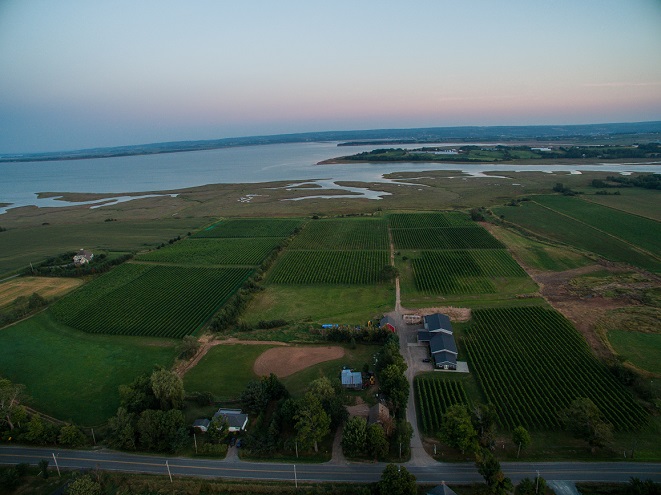
Simon, winemaker at the boutique Blomidon Estate Winery (above), reckons only 20% of the buds on their hybrid vines have survived. “It’s bad,” he confirms.
“We’re not pruning because we don’t want to cut anything off. We’re not thinking about making any wine this year. If we get anything off some of the hybrids, that will be a bonus. Basically, what we’re going to do is wait and see what grows, then we’ll go through and touch up.
“The goal for this year is to re-establish vines that make sense for the following year because I don’t know what kind of growth we’re going to have off them – if they’re alive.”
He adds: “Thankfully we’re a winery that makes a lot of non-vintage sparkling wine.”
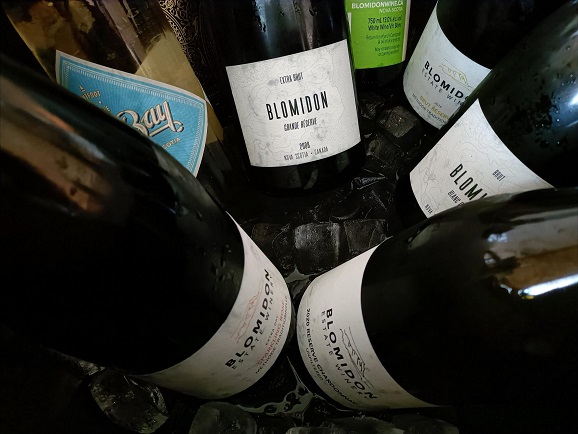
The winery in the Annapolis Valley has a beautiful seaside setting which underlines its location on the fringe for viticulture.
“You have to embrace the acidity. It just doesn’t drop here,” Simon says, as we taste through seven wines from Blomidon’s range. The latest releases of the vintage sparkling wines are dated 2016 and 2017. “They need that four or five years to soften up because if we disgorge them three years earlier and try to balance that acidity with a little more sugar, it just doesn’t work; it just tastes funny.”
He adds: “Nova Scotia wines seem to need lower dosage. They just do not support more sugar; they go sweet and sour. So, we tend to dose low (6-8g/L, with the Grand Reserve at 4g/L). Anything more than that just doesn’t taste right.”
Since 2016 he has shifted production of Blomidon’s two key wines, Cuvée L’Acadie and Brut Réserve, to non-vintage. They made this decision “to deal with vintage variation; to buffer out some of those unfortunate catastrophic years”. Like the frost of 2018 and the winter kill of 2023.
In a good year, they will also produce a blanc de blanc and a reserve Chardonnay, which is fermented and aged sur lie in French oak barrels for 12 months.
The hybrid L’Acadie Blanc goes into a sparkling wine, Cuvée L’Acadie, and a bright, crisp, floral white branded with the Tidal Bay appellation. This is a blend of approved varieties, such as Seyval Blanc, L’Acadie Blanc, and New York Muscat. Vidal, Geisenheim, Petite Milo, Ortega, and Pinot Gris are also permitted. The wine must also come from 100% Nova Scotia grown fruit, contain a maximum of 11% alcohol, and meet a certain style: crisp, fresh and bright with green fruit and distinct minerality.
The tasting with Simon is peppered with nuggets of fascinating detail:
- “All of our whites are whole-cluster pressed – it’s a safety net for us. We want as pure a fruit as possible.”
- Pressing is for a relatively long time – “very low, very slow” (if the season allows for this). “In a perfect season we’ll press over quite an extended period of time but very gently.”
- “We don’t ferment cold… We’re aiming for cool – 16-18˚C for the sparkling bases, 20-22˚C if we do some barrel work. After that we do very long lees contact; we tend to bottle our sparkling wines late – just before the next harvest. So, the wines will stay on lees until that point, when they are blended, bottled and into tirage.”
- Yeasts are “a bit of a mix,” Simon says. “Many of the base wines are inoculated, but the vinifera (eg. Chardonnay) that is barrel-fermented (in old oak) is all wild.” Some years, with the hybrids, he’ll use yeasts that “chew up a little bit of malolactic acid”; other years he’ll “let them go”.
‘While you’re on the fringe you have to make wines that fit that style’
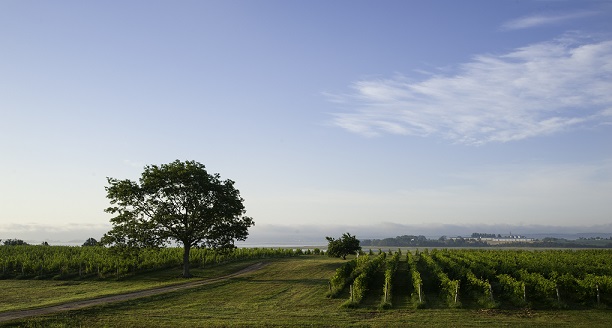
Despite the current setback, Simon sees great potential for this extreme, wind and sea-swept viticultural frontier.
“It doesn’t make it easy, but you can’t be unrealistic with what you want to achieve,” he says. “While you’re on the fringe you have to make wines that fit that style. It’s taken us a while to figure that out in Nova Scotia. But now, with our focus on traditional-method sparkling wines and a range like Tidal Bay, we’ve zeroed in on styles that actually fit our climate. In the past people have tried to do things to mimic other regions and I’m thankful we’re largely beyond that and now we can refine what Nova Scotia wines are.
“Working in a climate like Nova Scotia with a lot of varieties, it’s all about balance – finding the right style for where we are and what we’re doing and kind of letting the seasons and varieties dictate the style that the wines end up being rather than saying I want to make Champagne. I want our wines to have their own character. I think Nova Scotia wines in general do show a character and it’s putting that to the forefront.
“One of the interesting and challenging things about making wine on the margin – and with varieties that we’re not that familiar with – is you can’t follow a recipe. I can’t take the Champagne cahier des charges and say we’re going to take 500L of this and then so and so – you can’t just calculate it all out, you have to be more careful than that. When we’re pressing very delineated vintages you have to adapt to a given season and then adapt the grapes to a given style.”
He doesn’t – or can’t – make the same wines every year. “We’re always figuring it out year by year because every year is so different.”
Usually, as the season progresses, they decide whether they will be able to make more still or sparkling wine that year. If they decide it’s a good year for still wines, they start dropping fruit. “We’re always evaluating and deciding,” Simon states.
'We’re always evaluating and deciding'Fortunately, they currently have reserve wines in barrel so, as Simon says, “it’s not going to be an issue this year; it’ll be an issue next year. So, we have a year to plan and adjust our budgets accordingly.”
One of the two definitely dead blocks they plan to replant with Voltis, a hybrid approved for planting in Champagne.
For the future they are also considering geotextile covers for the vines at the 16ha estate.
The estate property sits at sea level on the shore of the Minas Basin and the Habitant River estuary, where the soils are predominantly sandy loam and the near constant breeze helps reduce frost and disease pressure. As well as the estate vineyard, Blomidon has the original Woodside Road vineyard, which runs along the base of the North Mountain, a basalt ridge that forms the north boundary of the Annapolis Valley. The soils there are a heavier red clay-loam with basalt stones. It’s warmer than the estate vineyard but can be more frost prone. The Woodside Road vineyard rises to an elevation of 60m above sea level.
The Blomidon estate vineyard features the oldest block of Chardonnay in Nova Scotia. The five-acre ‘Old Block’, as they call it, was planted in 1996 with a mix of clones. It sits on a gentle slope at the bottom of the vineyard, right on the shore. The Chardonnay from here usually forms the backbone of Blomidon’s premium wines.
The vineyards are significantly influenced by two bodies of water: The Bay of Fundy and the Atlantic Ocean. Both moderate the climate by delaying budbreak in the spring due to their cold waters and huge tidal shift (the highest tides in the world), but also by preventing frost in the autumn.
Typically, in Nova Scotia, Chardonnay will be picked in the second or third week of October for sparkling and as late as November for still wines. While Blomidon makes sparkling wine every year (using reserves and hybrid grape L’Acadie Blanc), the still wines are only made in better vintages when the conditions allow for the longer hangtime.
As you would expect from such a cool-climate region, the wines are lightly structured and elegant. Most are made in stainless-steel tanks, with some of the whole-cluster-pressed Chardonnay also going into older oak for both still and sparkling. Generally, the wines spend up to a year on lees.
Alcohol levels are on the low side (10-11%), but it suits the styles. “I don’t feel the need to have 12 or 13% on the label; I’m happy to put 10.5% on it. A lot of our sparkling wines are only 11.5% after the secondary fermentation. Many would consider that low, but it suits what we’re doing,” Simon says.
“Where we might chaptalize is some of the reds which need a little more body – under 12% they are lacking something. But we don’t do it systematically.”
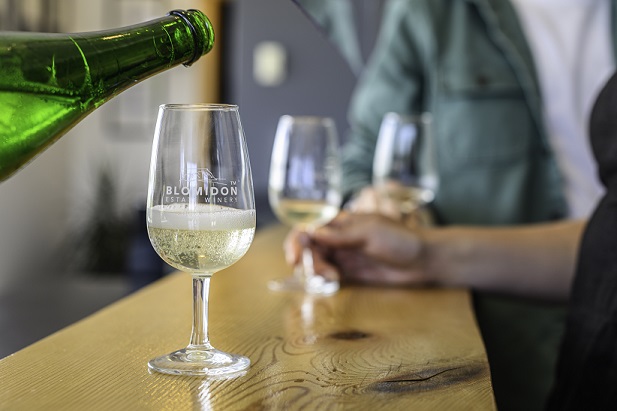
Ontario-born Simon has been the winemaker at Blomidon Estate Winery since 2009. He was offered the job by the Ramey family, after visiting his parents and going for a wine tasting there. The Rameys, who bought the estate in 2007, were impressed by his winemaking qualifications from France and his experience working in the Languedoc and Alsace, and in Central Otago, New Zealand.
He recalls his first vintage in his own country: “It just rained and rained and rained. In September, I started doing the maturity checks – they were nowhere near anything. October rolled around, and we’re still checking – but nobody seemed that perturbed by it. I was thinking we’re going to have to start picking sooner or later – winter’s coming! Anyway, we finally started going towards the end of October. We’re processing the grapes and getting the numbers in – the acidities are higher than the sugars. Having learned winemaking in the south of France, this is not a concept I was familiar with and I didn’t know what to do with it. In the end, we made some good wines that vintage, but it was a wake-up call.”
At the time, he didn’t have much sparkling wine experience either. “I was always interested in cool climate. I studied in Montpelier but then I went to Alsace and then Central Otago. I was also very interested in Rieslings, which is something I like to drink. But when I started at Blomidon they hadn’t put any sparkling in tirage yet. There was a base wine made, which is the 2008, but nothing was bottled so I kind of learned it on the fly. And at the time, Benjamin Bridge was starting with their winemaker Jean-Benoit Deslauriers and they had their consultant from Champagne and so he and I chatted an awful lot about this and that. A lot of it was trial and error too because we’re using varieties that people didn’t know very well, and we didn’t have that much experience with either.”
One of the most surprising things on Simon’s CV is that he came to winemaking through studying anthropology. “I had become interested in wine and grape-growing, and so I did my thesis on the response to climate change in the Languedoc-Roussillon region of France. This was shortly after the big European heatwave of 2003, when a lot of growers were prioritising sustainability and quality over yields. Anyway, I became really interested with the vineyards and winemaking, and I went from there.”
Since he’s been in Nova Scotia, he has noticed that the climate has become “significantly warmer”. “Winters are completely different – it was above zero until February,” he says. “We’ve had hurricanes earlier and later; last month in February it was -26˚C, the coldest temperature in Nova Scotia for 40 years or something like that. The wild swings in weather have become a more normal thing. It’s become really problematic; we’ve had two vintages since I’ve been there that were almost write-offs... It’s become challenging.”


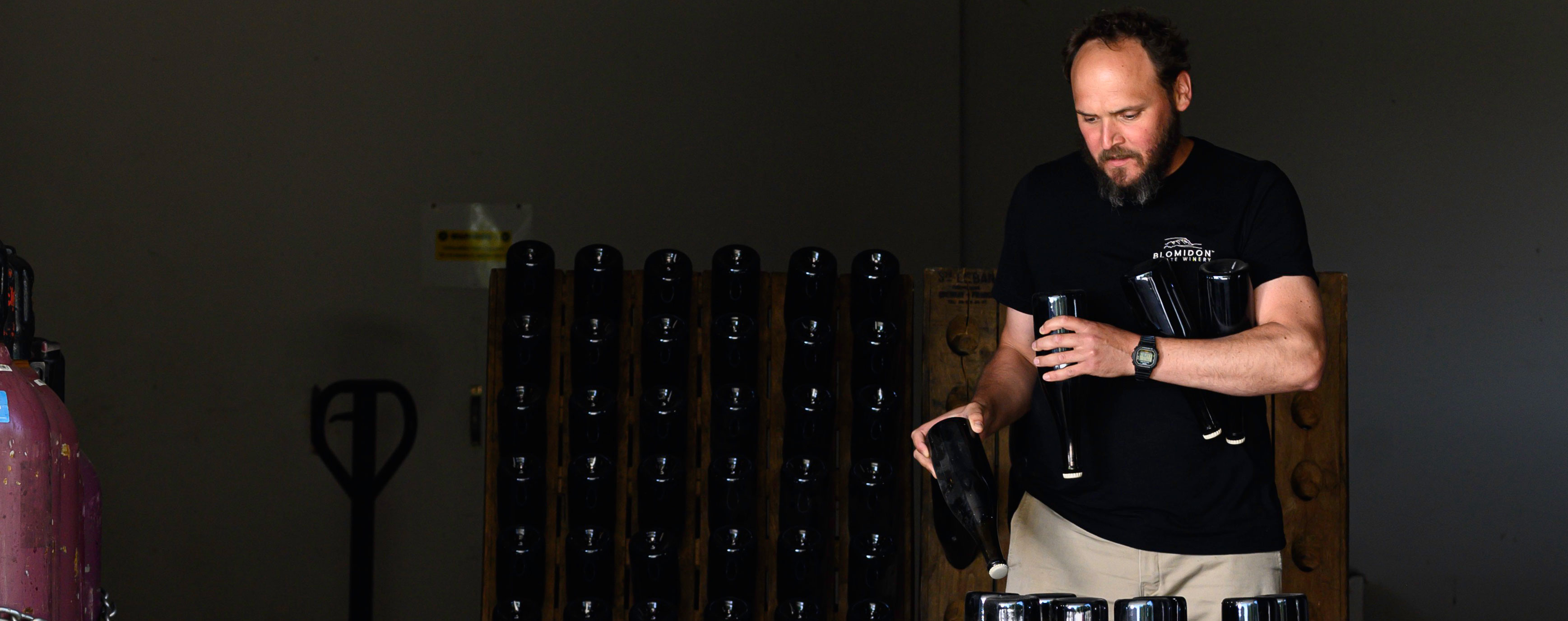










.png)






